Computer Science: Robotics and Coding for Elementary Level Learners
I absolutely love all of the new robotics toys that have been coming out for elementary age learners. I have been using them for my summer maker camp, with my gifted education classes, for my upcoming Saturday morning program, and for my summer camp. One of my gifted girls noted, “Where do all of these robots come from?” I laughed and told her, “It’s actually has become one of my passions. Collecting them has become a major hobby of mine.”
I am an advocate of student-centric learning and giving them choices as to which instructional activities they would like to engage. After going through a series of coding activities, I give them the following choices with their goal of using five of the robotics to complete five of the tasks provided.
My robotics-type devices include:
- Osmo Coding
- Sphero
- Ollie
- Dash and Dot
- Ozobot
- Quirkbot
- Makey-Makey
- micro:bit
- mbot
- Adafruit Circuit Playground
Binary Bracelets: Introduction to Coding
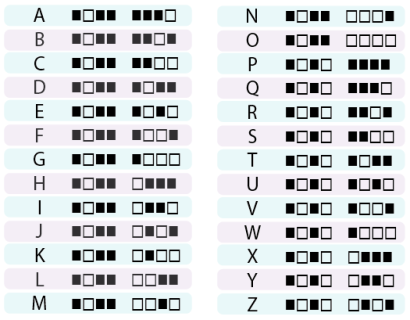
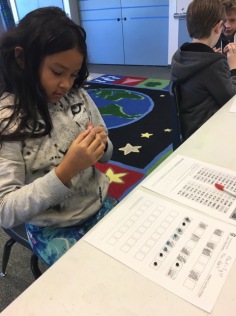
The craft activity involves letting the students make a stylish necklace for themselves, where their names are spelled out in binary using black and white beads. See https://bycommonconsent.com/2014/10/19/activity-day-girls-craft-idea-binary-code-necklace/ for further directions.
Board Games to Teach Coding: Introduction

Several board games that teach children computer coding concepts have been brought out recently. They make a good complement to online learning games and enable techie kids to have some fun family time away from a computer screen. http://www.techagekids.com/2015/11/board-games-teach-coding-kids-teens.html
The Task:
After learning a little bit about Robot Turtles, Code Monkey Island, and CodeMasters, play one or two of them.
Breakout Edu’s Caught in the Code: Introduction to Coding
We are caught in an infinite loop! Someone has re-written our classroom code and we are stuck. We will keep having the same day over and over unless we can find the correct code to de-bug the system. The correct code has been locked in the Breakout EDU box – once we figure out the combos, we will can escape the loop and move forward. http://www.breakoutedu.com/caught-in-the-code
and/or
Breakout Edu’s Haspy & Lockit: Code Buddies
Haspy the Robot needs your help! She was helping her friend Lockit run an update when there was a power surge and her circuit board shorted out. Unfortunately, this scrambled Lockit’s motherboard, flashed a few of her circuits, and wreaked havoc with her logic. Even though Haspy has the owner’s manual and has read what she needs to do, she is still a little confused. She needs your knowledge of loops, algorithms, and coding to help her fix Lockit’s code and reboot her system.
The Task:
The teacher will walk the group through this task.
Coding a Lego Maze

The LEGO mazes, which can be solved with “code” using paper rather than a computer, illustrate 4 levels of difficulty and include a variety of programming concepts (https://researchparent.com/coding-a-lego-maze/).
The Task:
The teacher will assist the learners in setting up and choosing the level most appropriate for them.
Code.org: Introduction to Coding
Code.org® is a non-profit dedicated to expanding access to computer science, and increasing participation by women and underrepresented minorities. Our vision is that every student in every school should have the opportunity to learn computer science, just like biology, chemistry or algebra. https://code.org/about
The Task:
As an introduction to robotics and computer science, do a few hours of tutorials via Code.org. The site, itself, offers a number of different tutorials, within their Hour of Code page – https://code.org/learn. Feel free to do the ones that look interesting to you.
Scratch Tutorials
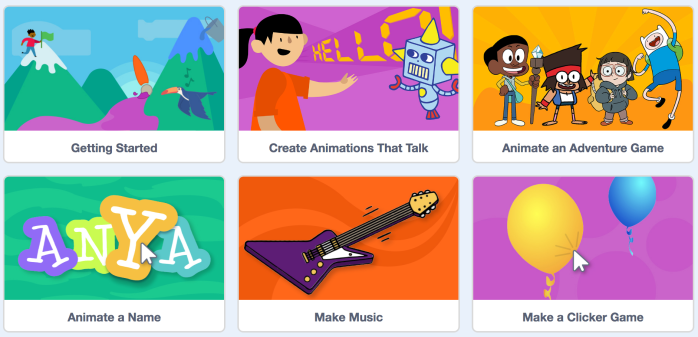
With the Scratch Tutorials, kids learn to code as they create interactive games, stories, music, and animations. Each card features step-by-step instructions for beginners to start coding with Scratch. The front of the card shows an activity kids can do with Scratch—like animating a character or keeping score in a game. The back shows how to put together code blocks to make the projects come to life! Along the way, kids learn key coding concepts, such as sequencing, conditionals, and variables (https://scratch.mit.edu/projects/editor/?tutorial=all).
The Task:
Complete a full series of two of the projects.
CoSpaces: Introduction to Coding
The Task:
After creating an account at CoSpaces using your school gmail, create a scene and use their Block coding to animate the people and objects in your scene. How-to directions can be found at https://youtu.be/0x-jdrwE7Ng.
Osmo Coding Awbie and Coding Jam
Osmo Coding uses hands-on physical blocks to control Awbie, a playful character who loves delicious strawberries. Each block is a coding command that directs Awbie on a wondrous tree-shaking, strawberry-munching adventure. https://playosmo.com/en/coding/
Kids love music, right? Now they can compose their own by arranging Osmo’s Coding Blocks into patterns and sequences. So it’s happy, hands-on play, and an awesome way to introduce Coding. Rock On! https://www.playosmo.com/en/coding-blocks/
The Task:
Play each game for 30 minutes and use each of the types of coding blocks during that time period.
Sphero and Ollie
“The app enabled ball that does it all” – that’s the tag line for Sphero 2.0. Sphero is robotic ball that connects to your smartphone or tablets over Bluetooth. It has built in multi-color LEDs that gives it light effect in combination of colors. It is waterproof, too. The free SPRK education program (which can be used with both Sphero and Ollie) has series of lab exercises to teach kids programming and robotics concepts. http://getstemgo.com/toys/sphero-and-ollie-robots-all-you-need-to-know-review/
The Task: The Maze
Program the Sphero or Ollie with the SPRK Lightning Lab app to navigate your own original maze made out of obstacles and materials in the learning environment. To complete this challenge, you must gather data about the best route through a maze and figure out how to build a program so Sphero can successfully navigate through the mayhem. More about this lesson can be found at https://sprk.sphero.com/cwists/preview/177x.
The Task: Painting with Sphero
Using a large piece of paper, different types of finger paints, the Sphero with the nobby cover, and the Lightening SPRK app, create a Jackson Pollack type painting. The full lesson plan can be found here – https://sprk.sphero.com/cwists/preview/152-painting-with-spherox
A “cleaner” alternative is to do a light painting with the Sphero using a long exposure app – see https://sprk.sphero.com/cwists/preview/78-light-paintingx
The Task: Battlebots
With a partner, create a Battlebot out of the Sphero or Ollie, cardboard, Popsicle sticks, and skewers. Challenge another team or two to a Battle. Last team with a balloon intact wins.
More lessons can be found at https://sprk.sphero.com/cwists/category
Dash and Dot
Dash & Dot are real robots that teach kids to code while they play. Using free apps and a compatible tablet or smartphone, kids learn to code while they make these robots sing, dance and navigate all around the house. Sensors on the robot mean they react to the environment around them. https://www.makewonder.com/
The Task: Rolling the Code
Using the Blockly app, complete the Dash and Dot Robots: Rolling for Code activity as described in http://www.thedigitalscoop.com/the_digital_scoop/2015/01/dash-and-dot-rolling-for-code.html

The Task: The Xylophone
Using the Xylophone and Xylo app, program Dash to play at least three songs.
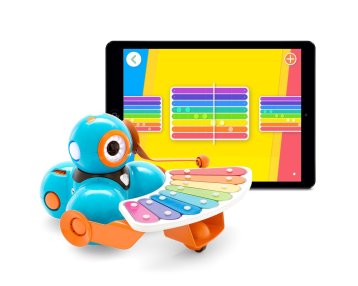
Ozobot
Control Ozobot with colors! Draw OzoCode color codes on paper or a tablet and Ozobot uses optical sensors to respond—spinning, speeding up and more at your command. It comes with an OzoCode chart and over 20 games and activities. Color coding masters can move on with free Ozobot apps and the OzoBlockly editor, which introduces block-based programming. http://ozobot.com/
The Task:
After playing with the Ozobot color based coding, learn how to use Ozoblocky – http://ozoblockly.com/. Teach two other learners how to use it.
Quirkbot
Quirkbot is a microcontroller toy that anyone can program. It is compatible with the open construction toy Strawbees and can be used along with readily available materials like regular drinking straws, LEDs, and hobby servos (motors) to create a wide variety of hackable toys. Let your creations express themselves and interact with their environment through sound, light and motion. https://www.kickstarter.com/projects/1687812426/quirkbot-make-your-own-robots-with-drinking-straws
The Task:
Go through the tutorials found at https://code.quirkbot.com/tutorials/getting-started/ and then build at least one of the Quirkbots found at https://www.quirkbot.com/build. Teacher’s guide can be downloaded: quirkbot-educators-guide-v0-9
Makeblock mbot
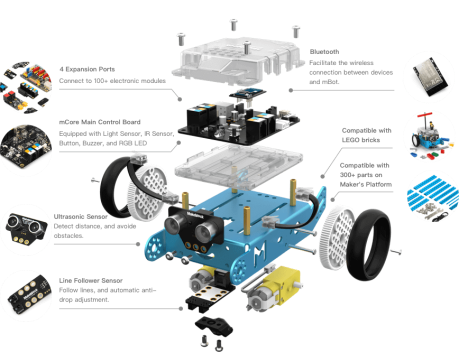
From the outset mBot, with its big adorable eyes and cute smiley face, has enthralled more than 4.5 million children worldwide. mBot is an educational playmate for children learning to build and program, and an excellent educational aid for teachers in STEAM lessons. mBot gets children to engage both their hands and their brain, encouraging them to exercise their interdisciplinary abilities while allowing them to experience the endless fun of creation at the same time (https://www.makeblock.com/steam-kits/mbot).
The Task:
Use the block coding via the app to make the mbot do at least 5 different things.
Parrot Drone
Parrot Airborne Cargo Mars is a robust, impact-resistant minidrone that can be customized in an instant. Quick flights and unlimited scenarios! Our nifty drones are packed with all the fun in the world and additional interactive opportunities : they offer unlimited learning possibilities in STEM and coding! https://www.parrot.com/us/minidrones/parrot-airborne-cargo-mars#learn-code-with-your-drone
The Task:
To use Parrot Blockly – https://activities.parrot.com/blockly– and do two of the projects found at https://activities.parrot.com/cwists/category.
Makey-Makey
Using the MaKey MaKey you can make anything into a key just by connecting a few alligator clips. The MaKey MaKey is an invention kit that tricks your computer into thinking that almost anything is a keyboard. This allows you to hook up all kinds of fun things as an input. For example, play Mario with a Play-Doh keyboard, or piano with fruit! https://www.sparkfun.com/products/11511
The Task: Hacked Poetry
Program the Makey-Makey with Scratch to read a poem – attach Makey Makey to four drawings made by pencil that represent that poem. Idea for this came from Makey Makey Hacked Poetry Month Part I.
The Task: A Small Group Project
With one or two of your classmates, do one of the projects found at http://makeymakey.com/guides/
micro:bit
You can use your BBC micro:bit for all sorts of creations, from robots to musical instruments. This little device has a lot of features, like 25 red LED lights that can flash messages. There are two programmable buttons that can be used to control games. Your BBC micro:bit can detect motion and tell you which direction you’re heading in, and it can use a low energy Bluetooth connection to interact with other devices and the Interne. http://microbit.org/about/
The Task:
For this advanced option, do two of the projects featured on http://www.makereducation.com/microbit.html
Adafruit Circuit Playground (advanced)
Circuit Playground features an ATmega32u4 micro-processor with contains within it: 10 x mini NeoPixels – each one can display any rainbow color; Motion sensor; Temperature sensor; Light sensor; Sound sensor (MEMS microphone); Mini speaker (magnetic buzzer); 2 x Push buttons – left and right; Slide switch; 8 x alligator-clip friendly input/output pins. You can power and program it from USB. Program your code into it, then take it on the go. https://learn.adafruit.com/introducing-circuit-playground/overview
The Task:
For this advanced option, do one of the projects featured on https://learn.adafruit.com/category/circuit-playground.



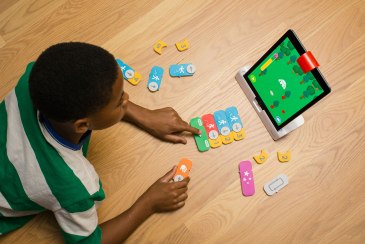
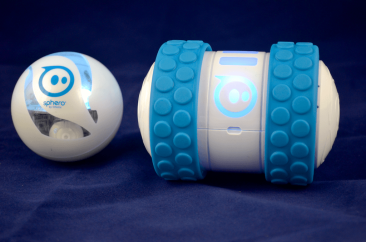






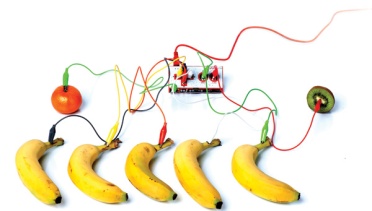


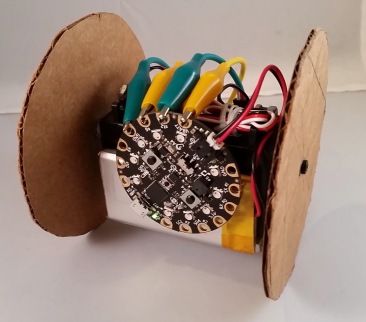

Leave a comment